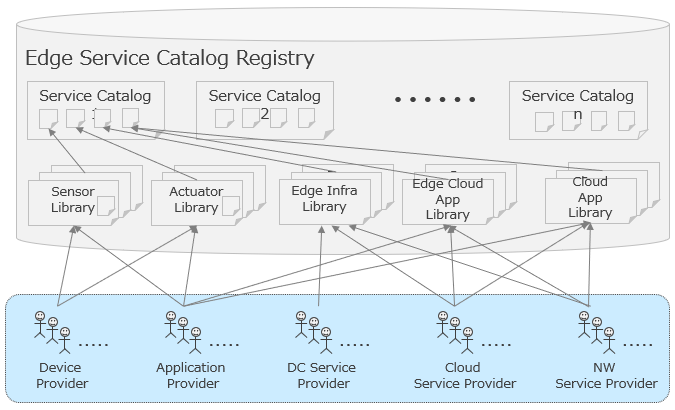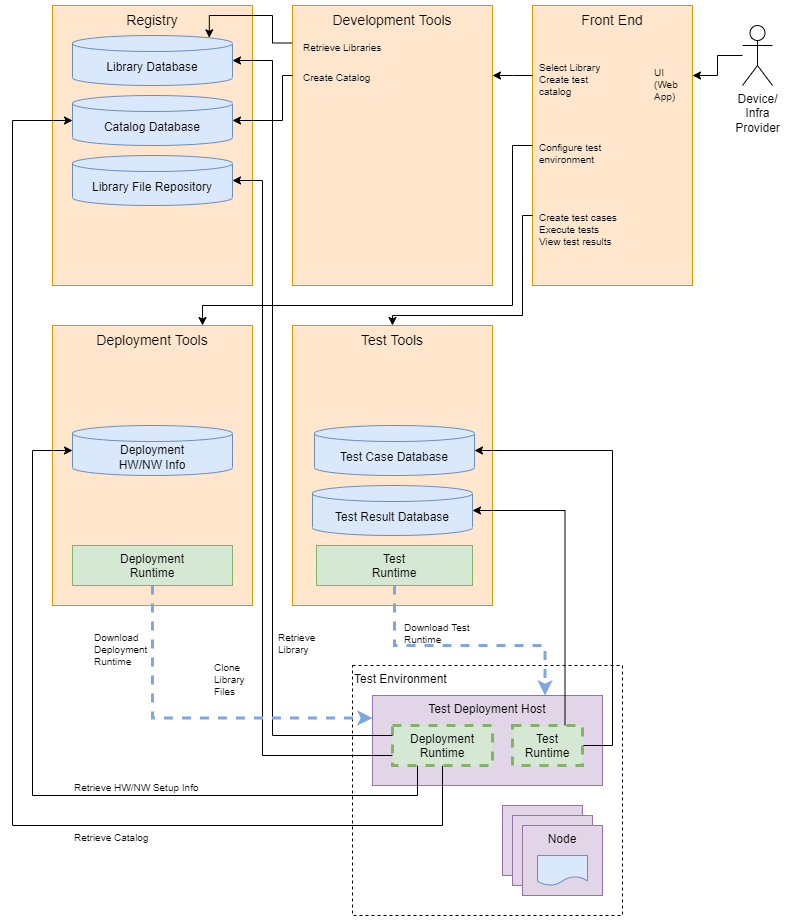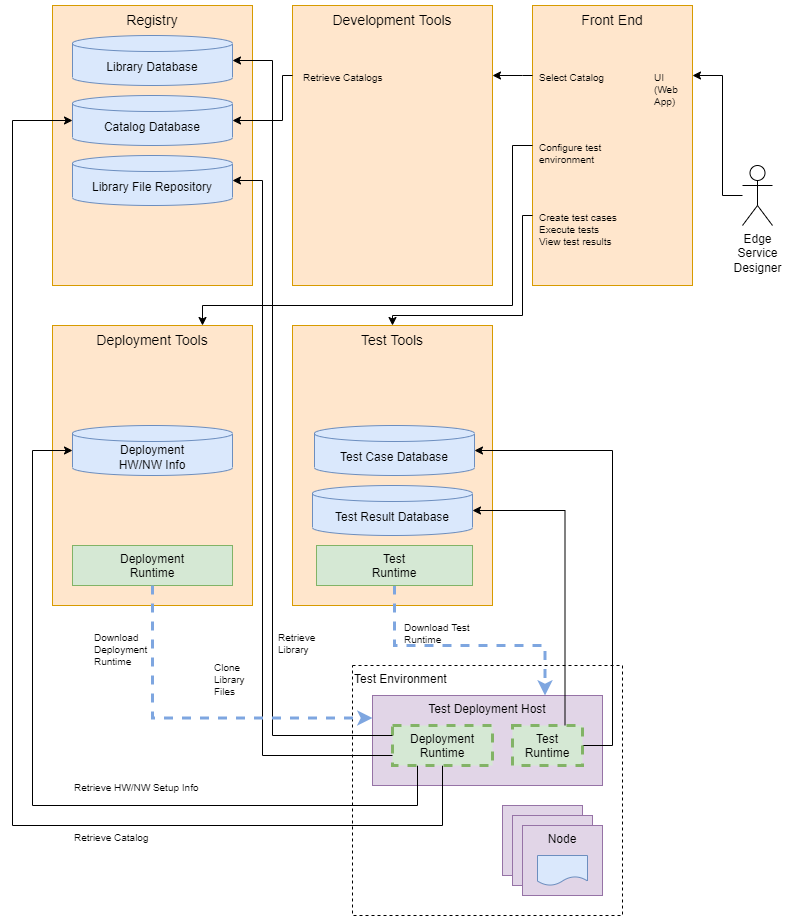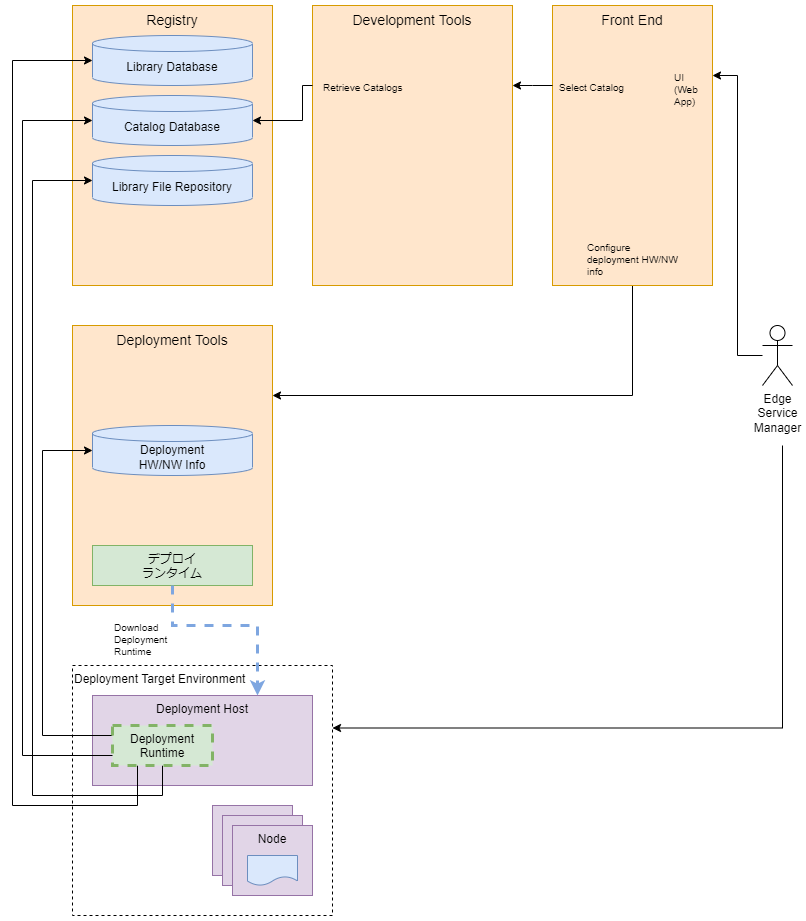...
The diagram below shows how edge service catalogs encapsulate the specialized knowledge of various device, application, and service providers into a package which can be deployed in the field with minimal configuration. This benefits both the person deploying the service, by reducing the cost and effort required to design and deploy the service, and the device and infrastructure suppliers, who will see greater use of their devices and infrastructure because of the reduced friction in using them.
Use Cases
...
Edge Service Design & Creation:
- Device & infrastructure providers benefit from being able to provide their device or infrastructure as a library included in the service catalog, easily customized and plugged in to a variety of edge service designs, expanding the number of users for their products.
- Edge service designers can create new service designs or extend existing ones without being required to create ad-hoc solutions for each device or infrastructure component they use.
- Edge service users can choose an edge service design that best fits their needs from a variety of available designs, and easily customize it for deployment with minimal knowledge of the complexities of each component in the design.
Where on the Edge
XXX
Business Drivers
The blueprint itself provides a service in the cloud, with connection to the edge through downloads of deployment tools and files to whatever type of target environment the service designers decide to enable. The vision is to provide the ability to deploy services arbitrarily close to the edge, possibly even including firmware or configuration of individual sensor devices. The initial release will focus on Unix-based platforms and gateways, with handling of more specialized devices to come in future releases.
Business Drivers
The blueprint consists of two key business driving resources: the service catalog and the edge service enabling platform.
The service catalog captures collective knowledge of device, application, and infrastructure experts, and in addition provides an abstract view of the various edge service components (technologies/resources/services) and the relationships between them. The service catalog enables edge service providers to focus on their strengths and easily design and develop a variety of edge services without having to go into the details of components they are unfamiliar with.
The edge service enabling platform provides lifecycle management for the service catalog and builds the edge services described within the service catalog, using services and resources from external infrastructure providers.XXX
Overall Architecture
The diagram below shows the overall architecture of this blueprint.
...
It is possible for one organization or even one individual to perform any number of these roles, or even all of them.
To further illustrate the proposed architecture, the sections below describe the high level interactions between the platform's components when performing the three major tasks of verifying libraries and catalogs, and deploying a catalog.
Verifying A Library
The diagram below shows the high level interactions when verifying a library using the platform. In order to verify the library operates properly, a basic catalog, consisting of the library and possibly other libraries it depends on, is defined. A set of one or more deployment configurations is also defined and stored in the deployment tools database of hardware and network information. The catalog and deployment configurations are deployed into the test environment. (The test environment could be provided by the library's developer, or it could be a shared resource.) The test runtime is downloaded from the test tools and used to run a series of test cases, which are retrieved from the test case database. The results of these tests are then stored in the test result database.
Verifying A Catalog
Verifying a catalog is very similar to verifying a library, except that the test cases focus on the operation and interaction of the libraries used by the catalog.
Deploying A Service
An edge service manager can deploy a service by selecting a catalog from the registry's catalog database, and configuring the deployment-specific information in the deployment tools' deployment hardware and network information. With that step complete the edge service manager downloads the deployment runtime to a suitable host in their target environment and the runtime retrieves the data for the required libraries, hardware and network configuration from the platform, running the deployment scripts for each library on the nodes where it is required.
Platform Architecture
The Edge Service Enabling Platform itself is intended to be implemented on a cloud platform. (The test environments and deployment target environments, of course, can have a wide variety of configurations.) The table below summarizes the platform requirements for each node component in the blueprint.
...
| Computing | Storage | Networking | |
|---|---|---|---|
| Front End | Consumer-grade x86 server or equivalent VM (> 2 cores) | Minimal storage for web application and logs (<100GB) | Public facing IP Load balancing (if user numbers require it) Private back-end IP interfaces to other components |
| Development Tools | Consumer-grade x86 server or equivalent VM (> 2 cores) | Application and log storage (< 100GB) | Back-end service IP |
| Registry | Managed database service or equivalent (DB sharding if loads require it) | Persistent library and catalog database storage (> 128GB) Library file repository (> 256GB) | Back-end service IP Load balancing (if loads require it) |
| Deployment Tools | Consumer-grade x86 server or equivalent VM (> 2 cores) | Application and log storage (< 100GB) Deployment HW/NW Info database storage (> 128GB) | Back-end service IP Public internet access for runtime push |
| Test Tools | Consumer-grade x86 server or equivalent VM (> 2 cores) | Application and log storage (< 100GB) Test case database storage (> 128 GB) Test result storage (> 256GB) | Back-end service IP Public internet access for runtime push |
| Authorization | User database storage (< 128GB) | Back-end service IP | |
| System Management | Consumer-grade x86 server or equivalent VM (> 2 cores) | Storage for auditing logs, installation files, etc. (<500GB) | Private back-end IP interfaces for component access |
...
Software Platform Architecture
The software components used by the blueprint are listed below. (TBD: Subject to revision and expansion as development proceeds.)
- OS: Ubuntu 20.04 or 22.04
- Services will be coded in Golang current stable release (1.18.3)
- Deployment runtime uses Ansible current stable release (5.8.0)
- Test runtime uses Robot Framework current stable release (5.0), running on Python 3.8.10
- Database components run on MongoDB Atlas instances provided by Google Cloud Platform
- Library file repositories run on Cloud Source Repository instances provided by Google Cloud Platform
APIs
No additional APIs are defined by this blueprint. (TBD: External APIs may be defined in the future.)
Hardware and Software Management
...



